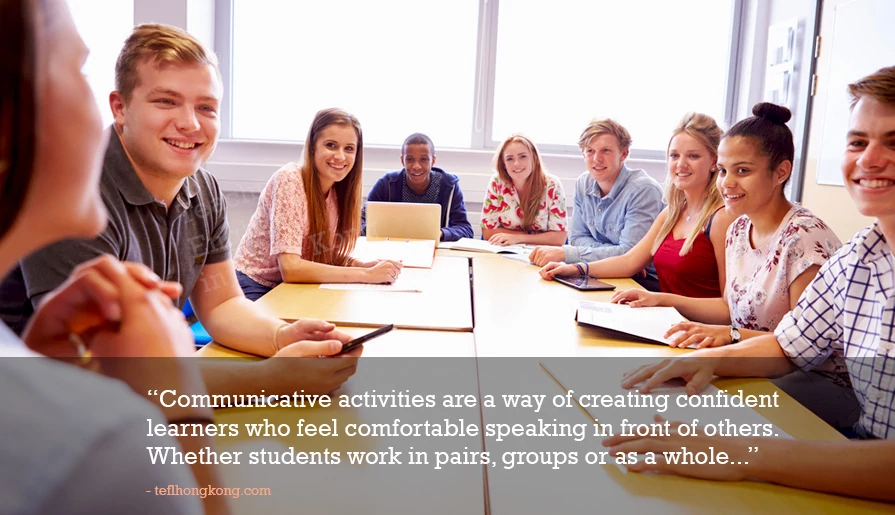
- By: Amy Heath
- In: ESL Activities
When I started my ESL teaching, I quickly discovered that my adult learners sometimes lacked the confidence of younger students, which can lead to hesitation when speaking and even avoidance of practicing their English out loud. I have found that my older students don’t really enjoy speaking activities as much as my teens and kids. They feel embarrassed or worry of making more errors.
If this sounds familiar or you’re simply looking for ways to increase student talk time, here are a few suggestions of effective activities that has worked for me and made my classroom a more communicative environment.
Before we look at the activities here is something to think about:
When pairing students for speaking, consider how comfortable they will be with their partner. Maybe you need to consider cultural background (do they feel comfortable with the opposite gender? do they always work with the same person and need a change?) Switching partners and working with new people will avoid repetition and the tedium of always working with the same person.
At the end of this article you’ll be able to find out:
- How to increasing student talking time in you ESL classroom, and..
- How to create confident communicators in your ESL classroom.
So, let’s start and move on to the student activities…
1. Role plays
I find that providing students with a relevant scenario and some tips for a role play allows them to communicate with more fluency. They can work in a pair or small groups and create their own dialogue. This means discussing what to put into the scene first and then it also provides enough time for practice, followed by reading the dialogue allowed to the other students.
Most students I teach feel better reading aloud in front of others if they feel what they have created is accurate and they have had adequate preparation time. With this in mind it is a good idea to monitor and provide guidance whilst they are in the planning stage.
Depending on the student’s level and topics you have been studying, the role play can be very simple and you can provide a clear structure and guidance, or it can be much more open.
“One language sets you in a corridor for life. Two languages open every door along the way.”
– Frank Smith
2. Hot seating
This activity is a favourite with many classes I teach and it is a great way to increase communication whilst also practicing forming questions. This works well under time conditions but it isn’t necessary to use a timer if you’d prefer not to.
Choose two students to be in the hot seat and have them work together to discuss a topic provided by you, for example the city where we live. Allow them some time to prepare a list of keywords and ideas based on the topic which will help them later on.
At the same time the other students must prepare two questions each (or 1 each if your class is very large!) which they will be asking the hot-seaters about the chosen topic.
When everyone is ready the hot-seaters sit in two chairs at the front of the room (the hot seats!) and the other students ask them questions. They reply and if necessary use their vocab and ideas list to help them.
I find that scaffolding the activity like this means students feel less nervous and are able to form more coherent responses and also feel more confident.
You can then discuss any errors after the activity (it’s better not to interrupt as this ruins the flow!) and then repeat the activity with a new topic. I use this as a chapter review and also as a warmer and plenary activity.
3. Image description
An easy to prepare communicative activity is describing an image. This reviews vocab and question forms, while allowing learners to practice word order too.
All you need to do is to provide a photo, an image, even a random page of the text book that includes photos if you use one.
Students must describe everything they can see in as much detail as possible. Their partner should ask questions to help them such as:
What is that?
What job do you think the man does?
.. and so on.
You may choose to make this a paired activity and use a timer to make it a bit more fun. You may also like to provide questions first or come up with them as a class beforehand.
This task works well at any level and can be made simpler or more complex based on the group’s ability.
“A different language is a different vision of life.”
– Federico Fellini
Show and tell is another easy and effective activity. This can be set as homework where you ask students to bring in a photo or an item that has meaning to them for their next class. They then present their item or photo to the group and students can ask questions to find out more. This is also a good way for students to learn more about each other.
For a more last minute version you can ask students to choose an item from their bag or pocket and do the same! They can talk about what it is, why they have it, where they bought it, why it is useful or important and so on. Again, the class can ask follow up questions too.
This is a very easy activity to model first as well to show students what you expect from them when it is their turn.
Also read: Tips to make young ESL learners love English lessons
Final Thoughts: Communicative activities are a way of creating confident learners who feel comfortable speaking in front of others. Whether students work in pairs, groups or as a whole class, the teacher’s role as an “encourager” and as someone who clearly sets ground rules and guidance is indispensable. Setting up the task is as important as the task itself and will allow everyone to participate with the assurance that they know exactly what to do and have the tools and ability to do it.
I hope that you are able to try out some of these activities with your classes and that they help increase the student taking time in your ESL classroom.
Also Read: 5 Must-know ESL Games, Activities a TEFL Teacher Should Know
Please Share:This article was originally published on June 19, 2019 and was last updated on August 30, 2021.
Courses We Offer:

1. CertTESOL: Certificate in TESOL
A level 5, initial teacher training qualification for new and experienced teachers, enabling you to teach English anywhere in the world. The course is equivalent to Cambridge CELTA.
Learn More
Developed by our Trinity CertTESOL experts, for a comprehensive, self-paced learning experience. Earn an internationally recognized certificate and master essential teaching skills, accessible globally 24/7.
Learn More